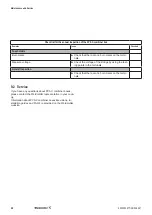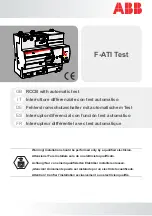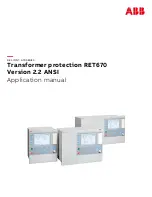
Installation
4000003077/00/02.2021
16
►
Regard the correct phase of the cables when connecting
the AC conductor to the appropriate terminal lug, ring
terminal or cage terminals and follow the instructions of
that component to crimp it in the right way.
►
Connect the AC conductors to the stud terminals or di-
rect to the switch disconnector.
► Check that all connections are performed according to
electrical drawing provided
► Check and apply the right tightening torques to the
terminal lugs of the switch disconnector. The correct
tightening torques can be found in the specific documen
-
tation inside each PV AC combiner box.
►
Tighten the cable glands.
► Make sure there is sufficient strain relief for the
AC main
lines/AC feeder cables.
► Close all unused cable glands with blanking plugs to
prevent moisture penetrating the combiner box.
Preparing aluminium conductors
– Aluminium conductors are only suitable for installation
sites that are free from humidity or aggressive atmos-
pheres.
– It is highly recommended to use bimetallic connectors.
–
Use neutral gease (e.g. acidfree and alkalifree vaseline)
to protect the surface of the alumimium from oxidation.
As a well known characteristic aluminium forms a thin,
non-conductive layer of oxide as soon as it is exposed to
the air. This layer increases the contact resistance between
the aluminium conductor and the current bar of the terminal
which can lead to poor contact. As a precondition regard
the following steps to prepare the aluminium conductors:
►
Scrape the stripped end of the conductor carefully, e.g.
with a knife, to remove the layer of oxide.
Do not use brushes, files or emery paper be
-
cause particles of aluminium can be deposited
on other conductors.
►
Coat the end of the conductor immediately with a neutral
grease, and connect it to the terminal immediately.
►
Tighten the screws of the DC-disconnector with the
maximum permissible tightening torque.
Repeat the above procedure each time after the
conductor has been disconnected and shall be
reconnected.
5.8 Connection of the grounding cable
The PV AC combiner boxes are designed with metallic
mounting plates. The enclosures are made of GFRP (Glass
Fiber Reinforced Polyester). Therefore the unique ground
connector is used for the surge protection. Note that the
earthing cable must be connected to provide the correct
operation of the surge protection device (SPD).
Protective conductors and other earthing conductors for
functional and protective purposes cannot generally be
considered as equipotential bonding dedicated for surge
and lightning protection.
According to the standard CLC-TS 50539-12, the cross
section of connecting conductors to SPDs on the AC side
of PV installations must be as follows:
– Earthing conductors of SPDs Type I+II shall have a min-
imum cross section of 16 mm
2
copper or equivalent or
equal to the cross section of live connectors, if greater
than 25 mm
2
.
– The cross section of the connecting conductors from
the SPD to live conductors shall not be smaller than the
cross section of the live conductors of the associated
circuit.































